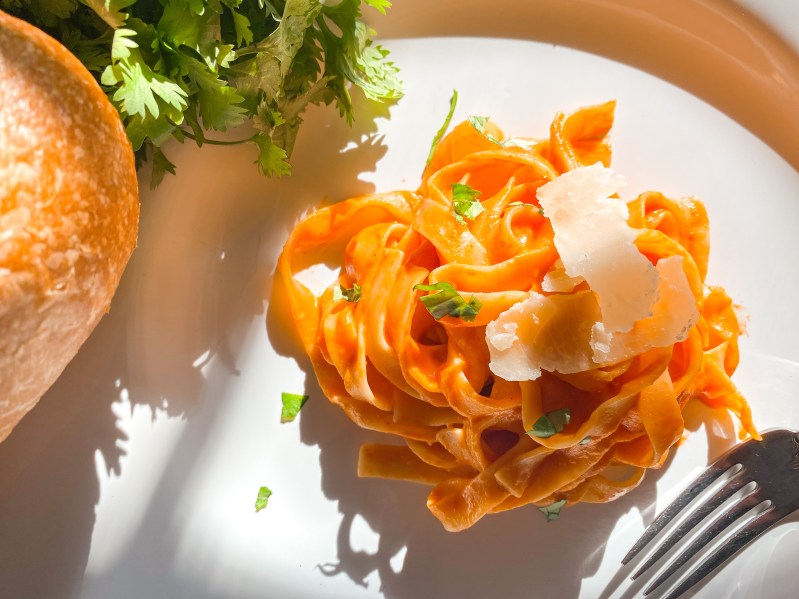This time of year, there’s no shortage of fall-themed soup recipes, and we’re here for it. Bring them on. We love them all. But the thing about soup is that there always seems to be so much leftover that after two or three days of eating the same thing, you’re ready to call it quits and toss it. Enter this recipe. Doubling as both a pumpkin soup and a pumpkin pasta sauce, this is one you’ll be making all fall and never tossing out.
This recipe is a favorite in my house for many reasons. Obviously, it’s an incredibly comforting fall dish that tastes like love. Its versatility also gives it major points — two totally different dishes made with one recipe? Done and done. But it’s additionally magical for those of us who are parents of picky eaters. Because the vegetables are pureed, kids won’t have any clue as to all of the wholesome nutrition that went into this dish. And if your kids are as young and picky as mine, you can get away with calling it “Fall Soup” or “Fall Pasta” and they’ll gladly accept your half-truth, as they devour these delicious, vegetable-packed dishes. No need to give them the full story. Believe me, I’ve tried. Don’t be like me.

Pumpkin pasta/soup recipe
Obviously, it’s completely up to you which of these two tasty choices you’d like to try first. I’ve found that it’s easier to enjoy as a soup first, as you can then simply toss your leftover soup into a pan of hot pasta and cook together the second time around. No need to heat the soup/sauce separately. Just return the drained pasta back to its pot, add the soup, and heat through.
It’s worth noting that you should always cook your pasta dishes this way. As much as it pains those of us who grew up with a ladleful of sauce plopped onto a pile of plain noodles, it’s just not how it should be done. When pasta and sauce are cooked together briefly, they have time to seduce each other, to come together as one, and truly blend into something wonderful. With the addition of a small amount of starchy pasta water, the sauce thins a touch and sticks to the noodles in a way it just doesn’t when added on the plate.
If however, you do choose to serve this as a pasta dish first, don’t forget to reserve some of the sauce before mixing it with your pasta. You’re going to want to enjoy the leftovers as soup. Or vice versa. Both dishes are amazing.
Ingredients:
- 6 tablespoons olive oil, divided
- One small Sugar Pie pumpkin (3-4 pounds)
- 1 yellow onion, diced
- 2 carrots, peeled and diced
- 1 celery stalk, diced
- 1/2 red bell pepper, diced
- 4-5 garlic cloves, minced
- 1/2 teaspoon nutmeg
- 1/2 teaspoon cinnamon
- 1/4 teaspoon red pepper flakes
- 32 ounces (4 cups) vegetable broth
- 1/2 cup heavy whipping cream
- 2 tablespoons butter
- Salt and pepper to taste
- Pepitas, for garnish
- Parmesan cheese, shaved, to finish
- 1 pound cooked pasta, any shape will do (for pasta dish)
- 2-4 tablespoons reserved pasta water, if desired (for pasta dish)
Method:
- Preheat the oven to 425F.
- Prepare a baking sheet by lining it with foil or parchment paper.
- Halve pumpkin and remove seeds and pulp.
- Slice pumpkin pieces into quarters and rub with 3 tablespoons of olive oil, season with salt and pepper.
- Bake 40-45 minutes until the pumpkin is fork tender.
- In a pot or Dutch oven over medium heat, warm 3 tablespoons of olive oil. When oil is hot, add onion, carrots, celery, bell pepper, and garlic. Saute until vegetables are tender.
- Scoop pumpkin flesh out of the skin and add to vegetables, stirring to combine.
- Season with nutmeg, cinnamon, and red pepper flakes, and add vegetable broth.
- Bring mixture to a boil, then reduce to a simmer for about 10 minutes.
- Remove from heat and blend using an immersion blender. When smooth, add cream and butter, then return to low heat until butter is melted.
- If serving as soup, serve with crusty bread, and top with pepitas and shaved parmesan.
- If serving as a pasta dish, pour mixture over cooked pasta, adding a tablespoon at a time of pasta water to thin consistency, if desired. Top with pepitas and shaved parmesan.



